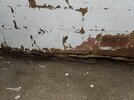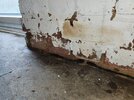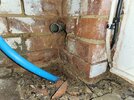- Joined
- 1 Apr 2022
- Messages
- 24
- Reaction score
- 0
- Country

Hey!
I'm pouring a new concrete screed in my garage and discovered the old slate DPC level is below the garage floor.
I'm guessing this would cause moisture bridging in the future. I was planning to chip away a bit at the concrete slab around the edges, put down a liquid DPM and prevent the bridging.
The concrete slab has no DPM.
Is it worth the extra work or should I leave it as it is.
Many Thanks!
I'm pouring a new concrete screed in my garage and discovered the old slate DPC level is below the garage floor.
I'm guessing this would cause moisture bridging in the future. I was planning to chip away a bit at the concrete slab around the edges, put down a liquid DPM and prevent the bridging.
The concrete slab has no DPM.
Is it worth the extra work or should I leave it as it is.
Many Thanks!



